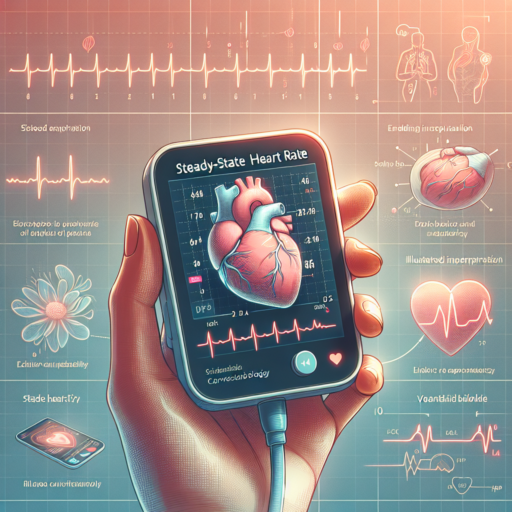Understanding the Basics of Heart Rate
Understanding the basics of heart rate is crucial for anyone interested in optimizing their health and physical performance. Heart rate, also known as pulse, is the number of times your heart beats per minute (bpm) and can vary depending on a variety of factors such as age, fitness level, and even the time of day. It’s an important indicator of your cardiovascular health and can provide insights into your overall well-being.
Measuring Heart Rate is a simple yet effective way to monitor your heart health. There are several methods to measure your heart rate, including using a heart rate monitor, checking manually at your wrist or neck, or employing smart devices and apps designed for this purpose. Regularly tracking your heart rate can help identify unusual patterns or irregularities that could indicate underlying health issues.
In understanding the basics of heart rate, it’s also essential to familiarize yourself with the concepts of resting heart rate and maximum heart rate. The resting heart rate is the number of heartbeats per minute when you’re at rest, offering a snapshot of your heart’s efficiency. On the other hand, maximum heart rate refers to the highest number your heart rate can reach during maximum physical exertion and is a critical factor in developing effective cardiovascular training programs.
The Significance of Monitoring Your Heart Rate
Monitoring your heart rate is not just a mere measurement; it’s a window into your cardiovascular health and your body’s overall well-being. Understanding how and why to keep track of your heart rate can empower individuals to make informed decisions about their health, fitness, and lifestyle choices. It’s a critical tool for everyone, from professional athletes to individuals keen on maintaining a healthy lifestyle.
Why Your Heart Rate Matters
At its core, your heart rate serves as a vital sign that reflects the health and efficiency of your cardiovascular system. A normal resting heart rate can range from 60 to 100 beats per minute for adults, but this figure can vary based on factors such as age, fitness level, and overall health. Monitoring changes in your heart rate over time can help identify potential health issues early, adjust your fitness routine, and even track recovery from illness or injury. Moreover, keeping an eye on your heart rate can also guide stress management techniques, offering insights into your body’s response to various stressors and relaxation practices.
Optimizing Fitness Through Heart Rate Monitoring
For those engaged in fitness and sports, understanding the relationship between heart rate and exercise intensity is paramount. It allows individuals to tailor their workouts more effectively, ensuring they train within their ideal heart rate zones for fat burning, endurance building, or peak performance training. Such targeted training not only enhances exercise efficacy but also minimizes the risk of overtraining and injury. Through consistent monitoring, athletes and fitness enthusiasts can optimize their workouts, track progress, and achieve their health and fitness goals more efficiently.
How To Accurately Measure Your Heart Rate
Understanding how to measure your heart rate accurately is vital for monitoring your fitness levels and identifying potential health concerns. This simple process can give you valuable insights into your heart health and overall well-being. By measuring your heart rate, you’re essentially gauging the effectiveness of your heart’s ability to pump blood throughout your body.
Choosing the Right Time and Place
To ensure an accurate measurement of your heart rate, it’s important to measure it under the right conditions. Ideally, try to measure your heart rate first thing in the morning right after you wake up but before you get out of bed. This gives you a resting heart rate, which is a vital baseline for understanding your heart health. Avoid measuring your heart rate immediately after physical activity or when you’re feeling stressed, as this can significantly affect the results.
Proper Technique for Measuring Heart Rate
To accurately measure your heart rate, you can use either your wrists, the side of your neck, or the top of your foot. Gently place your index and middle fingers on one of these areas until you can feel a pulse. Do not use your thumb because it has its own pulse that could interfere with your measurement. Once you’ve found your pulse, count the number of beats in 60 seconds for the most accurate reading. Alternatively, count for 30 seconds and multiply by two. This manual method gives a straightforward insight into your heart’s performance.
Recognizing the normal range for heart rates is crucial. For most adults, a normal resting heart rate falls between 60 and 100 beats per minute. However, factors like fitness levels, medication, and age can influence this range. If your resting heart rate is consistently outside of this range, it may be beneficial to consult a healthcare provider for further evaluation.
Identifying Your Normal Heart Rate Range
Understanding your normal heart rate range is crucial for monitoring your cardiovascular health. The heart rate, measured in beats per minute (BMP), varies significantly among individuals, influenced by factors such as age, fitness level, and presence of medical conditions. Identifying this range can help you assess your heart’s health, and when necessary, take steps to improve your cardiovascular fitness.
For adults, a resting heart rate between 60 and 100 beats per minute is generally considered normal. Highly trained athletes may have a resting heart rate below 60 BPM, reflecting their greater cardiovascular efficiency. However, it’s essential to recognize that what’s normal for one person may not be for another. Regular monitoring can help you understand your personal baseline.
Understanding Factors that Influence Heart Rate
- Age: As we age, changes in the heart rate and its regularity can occur.
- Activity Level: Regular exercise typically leads to a lower resting heart rate.
- Emotional Stress: Stress and anxiety can cause temporary increases in the heart rate.
To accurately identify your normal heart rate range, consider using a reliable measuring tool, such as a heart rate monitor, and consult with healthcare professionals. Regular measurement under various conditions – rest, during exercise, and post-activity – provides valuable data for understanding your heart’s health and its response to different stimuli.
Tools and Technologies for Heart Rate Monitoring
Keeping track of heart rate is crucial for athletes, fitness enthusiasts, and individuals monitoring their health for medical reasons. Fortunately, advancements in technology have significantly diversified the tools and techniques available for heart rate monitoring. From wearable devices to sophisticated medical equipment, the options are numerous and cater to various needs and preferences.
In the realm of wearable technology, smartwatches and fitness trackers are leading the charge in heart rate monitoring. These devices offer the convenience of continuous heart rate tracking without the need for bulky equipment. They utilize optical sensors to measure the blood flow through the wrist, providing real-time data that helps users optimize their workouts and monitor their health. Additionally, many of these devices come with companion apps that analyze heart rate data over time, offering insights into cardiovascular well-being.
Beyond wearables, chest strap monitors present another popular option. Known for their accuracy, chest straps measure electrical signals from the heart, similar to an EKG. They are especially favored by serious athletes and fitness professionals for their precision and ability to provide detailed heart rate data during intense physical activity.
Lastly, medical-grade heart rate monitors, while more commonly found in healthcare settings, are also available for personal use. These include advanced electrocardiogram (EKG) machines and portable event monitors designed to detect irregular heartbeats or arrhythmias. While they cater to a niche market, their contribution to heart rate monitoring technology cannot be understated, offering a level of detail and accuracy unmatched by consumer-grade devices.
No se han encontrado productos.
How To Interpret Your Heart Rate Readings
Understanding your heart rate readings is crucial for monitoring your cardiovascular health and optimizing your exercise regime. Your heart rate, or pulse, is the number of times your heart beats per minute (bpm) and it can tell you a lot about your fitness level, heart health, and overall well-being.
Know Your Resting Heart Rate
Your resting heart rate is the number of heartbeats per minute while you’re at rest. It’s best to measure it right after you wake up, before getting out of bed. An average resting rate is 60 to 100 bpm for adults. However, athletes often have a lower resting heart rate, sometimes as low as 40 bpm. Understanding your baseline can help you pinpoint when your heart might be working too hard or when you might need to increase your fitness level.
Determine Your Maximum Heart Rate
To effectively interpret your heart rate readings, it’s essential to understand your maximum heart rate (MHR), the upper limit of what your cardiovascular system can handle during physical activity. You can estimate your MHR by subtracting your age from 220. When exercising, you can determine the intensity level by comparing your current heart rate to your MHR. Typically, moderate-intensity activities should get your heart rate to 50-70% of your MHR, while vigorous physical activities may reach 70-85%.
By regularly monitoring and interpreting your heart rate readings, you can make informed decisions about your health and fitness routine. Recognizing the signs of when to push harder or when to ease back is critical for avoiding overtraining and reducing the risk of heart-related issues. Remember, the goal is not just to work harder, but smarter, by listening to what your heart is telling you.
The Connection Between Heart Rate and Exercise
Understanding the direct link between heart rate and exercise is fundamental for anyone looking to optimize their physical health and performance. Your heart rate, or pulse, is a vital indicator of how hard your heart is working during physical activity. As you engage in exercise, the demand for oxygen-rich blood increases throughout your body, causing your heart to beat faster to meet this higher requirement.
During exercise, monitoring your heart rate can be an effective tool for garessing the intensity of your workout. This relationship is crucial for designing a personalized exercise program that can help achieve specific fitness goals, whether it’s weight loss, endurance training, or strengthening the cardiovascular system. By understanding how to maintain your heart rate within various target zones, exercisers can maximize the efficiency of their workouts, ensuring they are pushing their limits without overexerting themselves.
The type and intensity of exercise directly influence your heart rate response. For example, aerobic activities like jogging, cycling, or swimming typically maintain a steady increase in heart rate, offering a clear example of how heart rate correlates with exercise intensity. Meanwhile, anaerobic exercises, such as weight lifting or sprinting, cause rapid surges in heart rate during short, intense bursts of activity. These variations highlight the importance of being aware of one’s heart rate during different forms of exercise, to tailor fitness regimes that cater to individual health and performance objectives.
Recognizing Abnormal Heart Rate Conditions
Identifying abnormal heart rate conditions is crucial for maintaining cardiovascular health. An essential step in this process involves understanding what constitutes an abnormal heart rate. Generally, a resting heart rate below 60 or above 100 beats per minute (bpm) may indicate an underlying problem. However, factors such as fitness level, medication, and even hydration status can affect heart rate readings.
Types of Abnormal Heart Conditions play a significant role in how they manifest and the potential hazards they pose. Common conditions include Tachycardia, where the heart beats excessively fast, and Bradycardia, characterized by an unusually slow heartbeat. Each condition has its own spectrum of severity and associated symptoms, from palpitations and dizziness to more severe complications like fainting or sudden cardiac arrest.
Early recognition and response to signs of an abnormal heart rate can be life-saving. Key symptoms include shortness of breath, prolonged chest pain, unexpected dizziness, or fatigue, especially if these symptoms appear suddenly. Professional evaluation and monitoring are essential to determine the underpinning cause and appropriate treatment for abnormal heart rate conditions.
Improving Your Heart Health Through Heart Rate Monitoring
Keeping a close eye on your heart rate is not just for athletes. Everyone can benefit from monitoring their heart rate to improve overall heart health. By understanding and observing your heart rate, you are taking a crucial step towards managing stress, optimizing workouts, and identifying any potential health issues before they become serious. It’s a proactive way to keep your heart running smoothly.
Why is Heart Rate Monitoring Important? It offers a window into the efficiency and performance of your heart. Regular monitoring can help you adjust your lifestyle to what best supports your cardiovascular system. Whether it’s through manual measurement or using a heart rate monitor, knowing your resting and active heart rates provides essential insights into your heart’s health and what you can do to improve it. Implementing heart rate monitoring into your daily routine could be the change you need for a healthier life.
Start simple by assessing your resting heart rate each morning and tracking how it changes in response to different levels of physical activity. Over time, you’ll begin to see patterns and understand how well your heart recovers after exertion—key indicators of heart strength and endurance.
Tips for Maintaining a Healthy Heart Rate
Maintaining a healthy heart rate is crucial for overall wellness and longevity. With the right lifestyle choices and habits, you can effectively manage your heart’s health. Here are several tips aimed at helping you keep your heart beating at a steady and healthy pace.
Engage in Regular Exercise
Physical activity plays a pivotal role in cardiovascular health. Engaging in moderate aerobic exercises such as walking, swimming, or cycling for at least 150 minutes a week can strengthen your heart muscle and improve its efficiency. Incorporating strength training a couple of times a week can further enhance heart health by reducing body fat, lowering blood pressure, and improving cholesterol levels.
Adopt a Heart-Healthy Diet
Eating a balanced diet is key to maintaining a healthy heart rate. Focus on consuming a variety of fruits, vegetables, whole grains, lean proteins, and healthy fats. Limit the intake of saturated fats, cholesterol, sodium, and added sugars, which can adversely affect your heart rate and lead to cardiovascular diseases. Foods rich in omega-3 fatty acids, such as salmon, and those high in fiber, like oats, are particularly beneficial for heart health.
Monitor Your Heart Rate Regularly
Keeping an eye on your heart rate can provide insights into your cardiovascular health. Use a heart rate monitor or smartwatch to track your rest and active heart rates. A resting heart rate of 60 to 100 beats per minute is generally considered normal for adults. Regular monitoring can help you notice any unusual changes, which should prompt a consultation with a healthcare provider to rule out any underlying issues.



